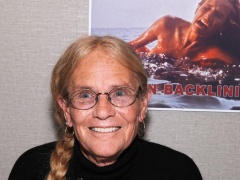
Suzanne Somers, who parlayed TV stardom in the sitcom hits “Three’s Company” and “Step by Step” into a personal fortune as a health and fitness pitchwoman and author, died Sunday in Palm Springs, Calif. She was 76.
“Suzanne Somers passed away peacefully at home in the early morning hours of October 15th. She survived an aggressive form of breast cancer for over 23 years,” Somers’ longtime publicist R. Couri Hay wrote in a statement on behalf of the actress’ family.
“Suzanne was surrounded by her loving husband Alan, her son Bruce, and her immediate family,” the statement continued. “Her family was gathered to celebrate her 77thbirthday on October 16th. Instead, they will celebrate her extraordinary life, and want to thank her millions of fans and followers who loved her dearly.”
The leggy blonde first attracted attention with a small but eye-catching role on the big screen, as the nameless beauty in a white Thunderbird who captivates departing college freshman Curt Henderson (Richard Dreyfuss) in George Lucas’ ‘60s hit comedy-drama “American Graffiti” (1973).
Small parts on TV and in film followed, but Somers finally hit the Hollywood jackpot in 1977 when, after a torturous development period in which the producers couldn’t settle on a fresh female lead, she was cast as one of the two female leads in the third, successful pilot for a suggestive new ABC comedy based (as were the earlier hits “All in the Family” and “Sanford & Son”) on a successful British show, “Man about the House.”
“Three’s Company” featured Somers as quintessential “dumb blonde” Chrissy Snow, roommate of the smarter and more level-headed Janet Wood (Joyce DeWitt) in an inexpensive Santa Monica apartment. John Ritter, the most familiar of the three stars, was top-billed as Jack Tripper, a culinary school student who jumps at the cheap housing, but he is forced to pose as a gay man to placate the girls’ landlord, who is opposed to opposite-sex tenants.
Feeding audiences a steady diet of improbable plotlines, Ritter pratfalls and double-entendre humor seasoned with Somers’ bubbling presence, “Three’s Company” vaulted to No. 3 in the national ratings in its first full season in 1977-78.
A Television Academy Foundation retrospective feature noted, “‘Three’s Company’ entered the television scene in the midst of TV’s ‘jiggle era’ that began in 1976 with ABC’s ‘Charlie’s Angels,’ and was the medium’s response to the sexual revolution and the swinging single. Three’s Company, though otherwise apolitical in content, was the first sitcom to address the sexual implications and frustrations of co-ed living, which in 1977 was still somewhat taboo. In the minds of many, male-female cohabitation was anything but innocent and, apparently, would lead only to the evils of premarital sex.”
It was a show that never stopped talking about sex even though none of its principal characters actually had any, but the titillation kept it lashed into the Nielsen top five through the beginning of its 1980 season. However, a widely publicized business conflict at the outset of season five ultimately resolved itself in Somers’ exit.
Somers demanded a five-fold increase in her salary to $150,000 per episode and a 10% cut of the show’s profits. Ritter and DeWitt were infuriated, producer Michael Ross balked and Somers’ role was ultimately reduced to a weekly walk-on bit; Chrissy’s brief scenes, staged as phone calls to her roommates, were shot separately. She was written completely out of the show in the aftermath of the ’80-’81 season, and Chrissy was replaced by other characters.
Somers never successfully transitioned to theatrical films, and in the immediate wake of “Three’s Company” she concentrated on a singing career in Vegas. She worked two seasons as star of the syndicated sitcom “She’s the Sheriff.” In 1991, she returned to ABC with a new sitcom, in which she was cast opposite the former star of another wildly popular hit of the ‘70s and ‘80s, Patrick Duffy of “Dallas.”
“Step By Step” followed a sitcom blueprint as antique as “The Brady Bunch”: Duffy and Somers played a divorced contractor and a widowed beauty salon owner who wed after a whirlwind romance and then contend with melding together their two families, comprising four children each from the previous marriages, under a single roof. PvNew’s Jean Rosenbluth called the series a “modestly amusing, occasionally heartwarming show,” and it got by on charm for eight seasons, jumping from ABC to end its run with a single season on CBS in 1997-98.
By that point, Somers was an extremely wealthy woman, with a personal multi-million-dollar business empire (overseen with her husband, former game show host Alan Hamel) built on her ubiquitous TV infomercials for the ThighMaster. Somers began to use the simple muscle-toning device, developed in Sweden, when she began work on “Step By Step,” and became the product’s highly visible national spokeswoman.
It was an instant hit. In 1992 Entertainment Weekly called it “the dirty little secret for the ‘90s. Don’t doubt the impact of this blue foam-covered apparatus with a red plastic center — just look at the legs it has given the career of its spokesperson, Somers. In the year she has been pitching ThighMaster, Somers, 45, has returned to the kitsch pantheon she occupied in the ‘70s.”
The fortunes of Somers and Hamel continued to flourish after the couple bought out their financially struggling partners and assumed sole ownership of the ThighMaster and a companion fitness product: the ButtMaster. In a 2022 “Hollywood Raw” podcast interview, host Dax Holt ran numbers offered by Somers and estimated she had made $300 million from the sale of the original equipment alone.
She became an industry unto herself, peddling a panoply of health and beauty products on her own web site and Home Shopping Network and penning more than two dozen books on wellness, aging, weight loss and sex. (She also published a volume of poetry.)
Her ideas about medicine were not always embraced by professionals. Her embrace of bioidentical hormone replacement therapy as a treatment for menopause came under fire; after she survived stage II breast cancer in 2000, she promoted alternative medical treatments in her book “Knockout,” drawing fire from the American Cancer Society.
Somers never completely abandoned show business, keeping her hand in as co-host of the venerable “Candid Camera” in 1997 and host of the 2012 Lifetime talker “The Suzanne Show” and a 2012 online talk show, “Breaking Through,” on which she reconciled with her estranged “Three’s Company” co-star DeWitt. (She had made peace with John Ritter at his hospital bedside before his death from a heart ailment in 2003.) She took a spin on “Dancing With the Stars” in 2015.
Somers’ celebrated rise was something of an improbable tale, as her early life was especially difficult, challenging and troubled. She would recall her tumultuous upbringing and family life in an unflinching 1988 memoir, “Keeping Secrets,” which would serve as the basis of a 1991 ABC movie in which she played herself (with David Birney as Hamel) and (using material from a second autobiographical volume, 1998’s “After the Fall”) a short-lived one-woman Broadway show, “The Blonde in the Thunderbird.”
She was born Suzanne Marie Mahoney in San Bruno, Calif., on Oct. 16, 1946. Her father, a day laborer, was an abusive alcoholic; over time her siblings, sister Maureen and brothers Daniel and Michael, would also suffer from alcoholism. A dyslexic growing up amid constant domestic turmoil, she was a poor student at the Catholic schools she attended in the San Francisco Bay area.
At 19 she married her boyfriend Bruce Somers after she became pregnant; her only child, Bruce Jr., was born in 1965. The marriage ended three years later after her husband learned she was having an affair with her dramatic coach.
Somers undertook a modeling career, and while working as a prize model on the syndicated game show “The Anniversary Game,” which was produced in San Francisco, she became romantically involved with its Canada-born host Hamel, who was then married.
In 1971 her son, who was suffering from emotional problems, was seriously injured when he was hit by a car; struggling to pay his hospital bills, she did a test nude photo session for Playboy (for which she was belatedly paid by the magazine after she filed suit over the photos’ unauthorized publication). Both mother and son began to see the same therapist to recover from their personal trauma.
Somers made her film bow in a small part in the San Francisco-set Steve McQueen action vehicle “Bullitt” (1968). After relocating to Hollywood, she landed TV roles on “The Rockford Files,” “Starsky & Hutch” “The Love Boat” and “One Day at a Time.” Her movie work included a bit in Clint Eastwood’s second Dirty Harry entry “Magnum Force” (1973) and “Billy Jack Goes to Washington” (1977), the unsuccessful fourth installment of Tom Laughlin’s film series.
As her career finally lifted off with “Three’s Company,” Hamel, now divorced, and Somers finally married in 1977.






